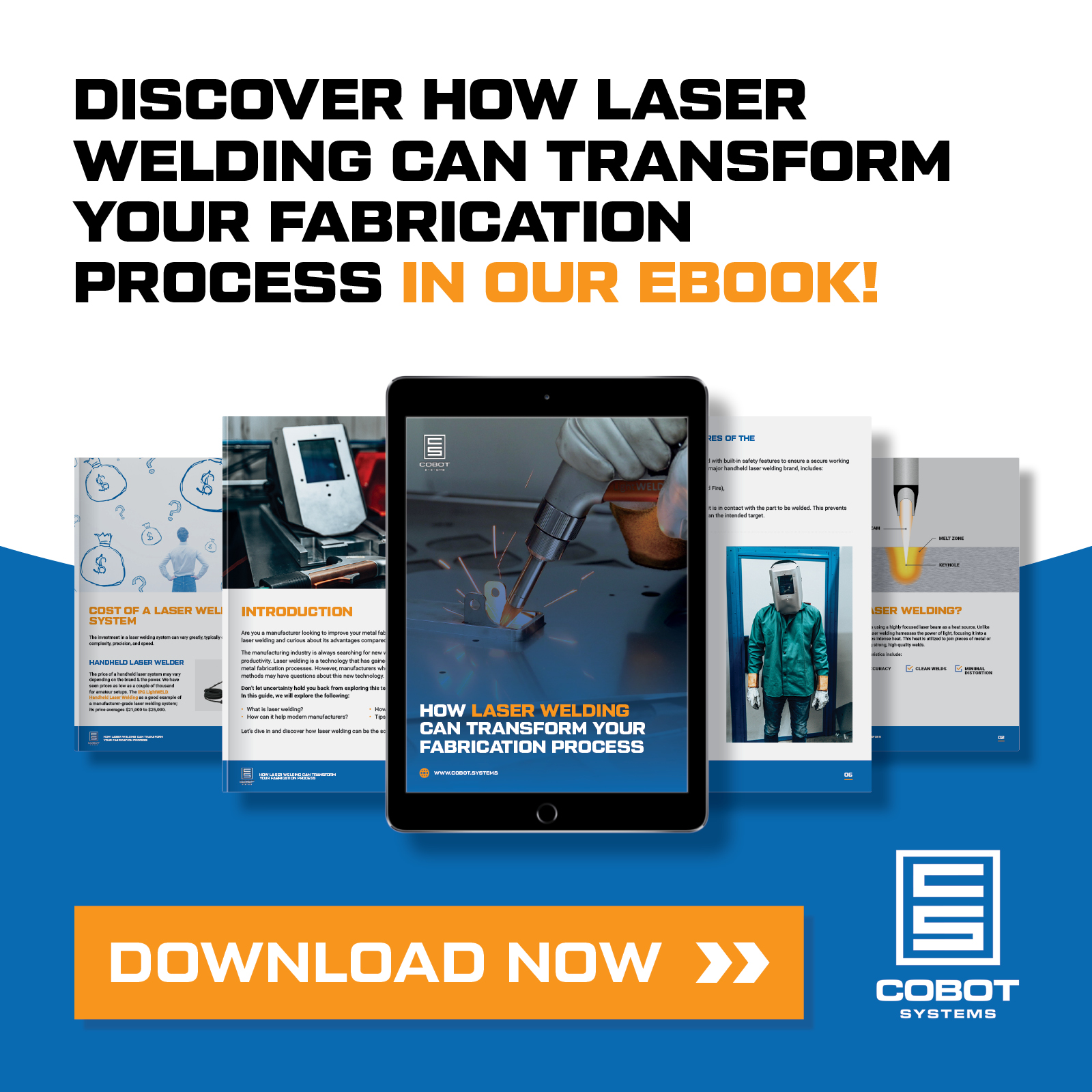Laser welding is changing metal fabrication, offering precision and speed that traditional methods can’t match.
According to a recent report by Future Market Insights, the global laser welding market is projected to reach $2.9 million in 2024 and grow to $5.1 million by 2034, driven by increased demand in industries like automotive, electronics, and aerospace.
In this article, we’ll cover the four main types of lasers used in welding: Solid state, direct-diode, fiber, and gas.
We’ll discuss the pros and cons of each type and why a specific type might be best for your needs. We’ll also look at how automating laser welding with cobots can boost your manufacturing efficiency and quality.
Solid State Lasers
Solid state lasers, including Nd and Yb, are known for their high beam quality. These lasers are excellent for detailed work and offer a great solution for various industrial applications.
Solid state lasers are ideal for welding applications requiring high precision and versatility.
Industry Applications:
• Automotive: Used for welding small, intricate parts such as sensors and components that require high precision.
• Medical: Essential for manufacturing medical devices and surgical tools that demand clean and precise welds.
• Aerospace: Suitable for creating complex components that must withstand high stress and environmental conditions.
Strengths and Weaknesses of Solid State Lasers
Aspect
Strength
Weakness
Flexibility
Highly flexible, and suitable for a variety of welding tasks, from fine details to structural welds.
Requires a more sophisticated setup and maintenance compared to other types.
Material Compatibility and Thickness
Effective on a wide range of materials, including metals, ceramics, and polymers. Can weld thin sheets and intricate components with high precision.
Not as effective for welding thicker materials or highly reflective metals like aluminum without additional adjustments or coatings.
Joint Configuration
Excellent for welding complex joint configurations due to precise control over the laser beam.
Requires precise alignment and fixturing to ensure optimal joint quality.
Welding Speed
Provides moderate welding speeds, suitable for applications where precision is more critical.
Slower compared to some other laser types like fiber lasers, which can impact overall production efficiency in high-volume settings.
Direct-Diode Lasers
Direct-diode lasers use high-powered laser diodes to produce a concentrated beam of light, making them efficient and compact. These lasers are particularly suited for applications that require high-speed processing and lower power consumption.
Direct-diode lasers operate at wavelengths (typically around 800-1000 nm) that are well absorbed by a range of metals, including steels and non-ferrous metals. This capability makes them effective for welding tasks that require deep penetration and strong joints.
Industry Applications:
• Automotive: Used for welding thin metal sheets and components in car manufacturing, including body panels and battery enclosures.
• Electronics: Used in the production of small, intricate electronic parts where precision and speed are essential.
• Consumer Goods: Applied in the assembly of various consumer products that require efficient and high-speed welding processes.
Strengths and Weaknesses of Direct-Diode Lasers
Aspect
Strength
Weakness
Flexibility
Highly flexible, and suitable for a variety of high-speed welding tasks.
Limited by lower peak power compared to other laser types, restricting some applications.
Material Compatibility and Thickness
Effective on thin metals and suitable for a range of materials, including stainless. aluminum, steel and copper.
Not ideal for welding thicker materials without additional adjustments.
Joint Configuration
Suitable for simple to moderately complex joint configurations due to precise control.
Less effective for highly complex joints requiring deep penetration.
Welding Speed
Provides high welding speeds, making it ideal for high-volume production environments.
May compromise on weld quality at high speeds, requiring careful optimization.
Fiber Lasers
Fiber lasers (Single-Mode, Multi-Mode, Q-Switched, Continuous Wave) use an optical fiber doped with rare-earth elements as the gain medium, which results in high power output and excellent beam quality.
They are known for their efficiency, flexibility, and robustness, making them a popular choice in various industrial applications.
Fiber lasers are best suited for applications requiring high precision, high power, and flexibility.
Industry Applications:
• Automotive: Used for welding car bodies, engine components, and battery systems due to their ability to handle high-speed welding with precision.
• Aerospace: Ideal for welding intricate components that require high strength and minimal thermal distortion.
• Electronics: Employed in manufacturing electronic components and circuit boards where precision and minimal heat impact are crucial.
Strengths and Weaknesses of Fiber Lasers
Aspect
Strength
Weakness
Flexibility
Highly flexible, suitable for a wide range of welding tasks from micro-welding to heavy-duty welding.
Initial setup can be costly due to the high price of fiber laser systems.
Material Compatibility and Thickness
Excellent compatibility with a wide range of materials including metals, polymers, and composites. Can weld both thin and thick materials with high precision.
Reflective materials may require adjustments to avoid back reflections.
Joint Configuration
Suitable for complex joint configurations, offering precise control over the weld beam.
May require precise alignment and fixturing to ensure optimal weld quality.
Welding Speed
Provides high welding speeds, making it ideal for high-volume production environments.
At very high speeds, careful optimization is required to maintain weld quality.
Fiber Lasers for Handheld Welding and Automation
Fiber lasers are ideal for handheld welding and automation due to their compact size and efficiency. Just like the LightWELD handheld laser welder from IPG. This versatile tool works on various materials and thicknesses, and delivers flawless results with minimal distortion, deformation, undercutting, or burn-through.
It’s easy to learn and 4X faster than manual TIG welding. Unlike MIG welding, the handheld laser welder accommodates a wide range of travel distances, angles, and vertical positions.
With LightWELD presets, welders can weld various materials and thicknesses with minimal downtime between tasks. Its portability allows for use on large, difficult-to-move, or oddly shaped workpieces, improving flexibility in both handheld and automated applications.
Gas Lasers
Gas lasers, particularly CO2 lasers, use a gas mixture (primarily carbon dioxide) as the medium to produce a high-powered infrared laser beam. They are known for their ability to cut and weld a wide range of materials with high efficiency and precision.
CO2 lasers are effective in welding metals such as steel, stainless steel, and aluminum.
Industry Applications:
• Automotive: Used for cutting and welding body panels, exhaust systems, and other components where precision and speed are critical.
• Aerospace: Ideal for cutting and welding large, intricate parts that require minimal thermal distortion.
• Manufacturing: Used in cutting and welding a variety of materials, including plastics, glass, and textiles, making them versatile for general manufacturing purposes.
Strengths and Weaknesses of Gas Lasers
Aspect
Strength
Weakness
Flexibility
Versatile and can handle a variety of cutting and welding tasks, especially for non-metallic materials.
Bulky setup and require significant space for the equipment.
Material Compatibility and Thickness
Effective on a wide range of materials. Can cut and weld thick materials efficiently.
Not as effective for welding reflective metals without additional coatings or adjustments.
Joint Configuration
Suitable for welding simple to moderately complex joint configurations with good precision.
Less effective for highly complex joints requiring deep penetration.
Welding Speed
Provides high welding speeds, making it suitable for high-volume production environments.
Can be slower than fiber lasers for certain applications.
Heat Impact
Produces a minimal heat-affected zone (HAZ), reducing the risk of thermal distortion in many materials.
Requires careful control to avoid excessive heat build-up and potential damage to delicate materials.
Manual Vs Automated Laser Welding
Manual laser welding involves an operator manually guiding the laser to perform the welding tasks, requiring a high level of skill.
Automated laser welding, on the other hand, uses robots or cobots (collaborative robots) to carry out the welding process with minimal human intervention, ensuring consistent quality and repeatability.
The Differences
Control and Precision
• Manual welding: Highly reliant on the operator’s skill. Offers flexibility in handling complex tasks that might not be easily automated.
• Automated welding: Provides consistent precision and quality with programmed accuracy, reducing the variability caused by human factors.
Speed and Efficiency
• Manual welding: Slower and more labor-intensive, which can lead to lower production rates.
• Automated welding: Faster and more efficient, capable of operating continuously with minimal downtime.
Safety
• Manual welding: Higher risk of exposure to hazardous fumes, intense light, and heat, requiring extensive safety measures.
• Automated welding: Enhanced safety due to the reduced need for human presence in hazardous environments, with robots handling dangerous tasks.
Laser Welding with Cobot Systems for High-Quality, Repeatable Jobs
Cobot Systems specializes in advanced laser welding solutions, delivering high-quality, repeatable performance through the use of collaborative robots.
We provide a comprehensive suite of products, including the Laser Welding Cobot System, IPG Hand Held Laser Welder and CNC Machine Tending Cobot System.
We understand automation and application needs. Unlike typical robot integrators or distributors who focus mainly on automation, we bring a unique perspective from years of CNC machine tending and laser welding.
This hands-on experience means we understand real-world applications and how they need to work in your shop.
By partnering with us, you’re investing in laser technology and gaining access to a team of experts who truly understand what it takes to succeed in today’s competitive manufacturing environment.
FAQ
Can laser welding be used for both ferrous and non-ferrous metals?
Yes, laser welding can be used for both ferrous (e.g., steel, stainless steel) and non-ferrous metals (e.g., aluminum, copper). The choice of laser type and specific parameters need to be adjusted according to the material properties. For example, fiber lasers are often preferred for welding highly reflective materials like aluminum due to their efficiency in handling reflections.
How does the heat-affected zone of laser welding compare to other welding methods?
The heat-affected zone in laser welding is typically much smaller than in traditional welding methods such as MIG or TIG welding. This reduced HAZ minimizes thermal distortion and preserves the mechanical properties of the material being welded.
What are the typical maintenance requirements for laser welding systems?
Maintenance requirements for laser welding systems include regular cleaning of the laser optics, checking and replacing consumables (such as lenses and nozzles), and ensuring proper alignment of the laser beam. Preventive maintenance schedules are essential to avoid downtime and ensure consistent performance. Automated systems may also require software updates and occasional recalibration.
Are there specific safety considerations unique to laser welding?
Yes, laser welding involves specific safety considerations, including the need for protective eyewear to shield against the intense light emitted by the laser. Additionally, proper ventilation is required to manage fumes and gases generated during the welding process. Laser safety enclosures or barriers are often used to prevent accidental exposure to the laser beam.
How does laser welding handle joint configurations that are difficult for traditional welding methods?
Laser welding excels at handling complex joint configurations due to its precise control over the laser beam. It can perform deep penetration welds and create narrow, high-aspect-ratio welds with minimal distortion. This capability is particularly beneficial for intricate assemblies and components where traditional welding methods may struggle to achieve the required accuracy and strength.





